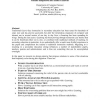Free Online Productivity Tools
i2Speak
i2Symbol
i2OCR
iTex2Img
iWeb2Print
iWeb2Shot
i2Type
iPdf2Split
iPdf2Merge
i2Bopomofo
i2Arabic
i2Style
i2Image
i2PDF
iLatex2Rtf
Sci2ools
EUROPLOP
2006
2006
Migrating to e-Learning in Secondary Education
Traditional face-to-face instruction in secondary education has been tested for hundreds of years now and has proven successful, but after the tremendous expansion of computer and internet use in several sectors of our day to day lives, e-Learning has been spreading its wings. During the last years e-Learning has been proving through numerous case studies that it can be beneficial either on its own, or combined with traditional methods of teaching. In secondary education in particular, it can undoubtedly offer a much more fruitful experience to the pupils and complement the teacher's traditional instruction methods. Migrating to eLearning in a secondary education setting influences a number of stakeholders: pupils, teachers, parents and administrators and is thus not something that can be accomplished overnight. In this paper we present six design patterns that propose solutions to some of the situations that frequently occur during this migration. These are:
E-learning | EUROPLOP 2006 | Programming Languages | Secondary Education | Traditional Face-to-face Instruction |
| Added | 31 Oct 2010 |
| Updated | 31 Oct 2010 |
| Type | Conference |
| Year | 2006 |
| Where | EUROPLOP |
| Authors | Michalis Hadjisimou, Aimilia Tzanavari |
Comments (0)

